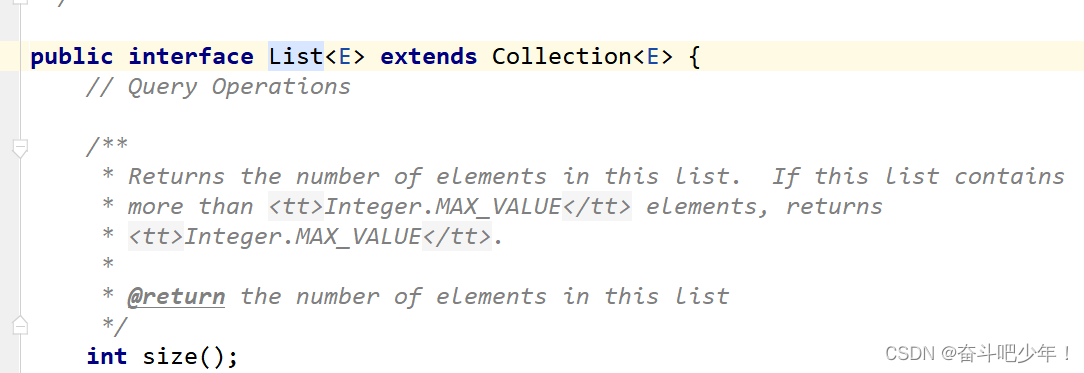JAVA集合III-List
1.List接口
(1)List接口是Collection接口的子接口,看源码:

(2)List集合类特点
- List集合类中的元素有序(即添加顺序和取出顺序一致)、且可重复
- List集合中的每一个元素都有其对应的顺序索引,即支持索引。
- List容器中的元素都对应一个整数型的序号,记载其在容器中的位置,可以根据序号存取容器中的元素。
- JDK API中List接口的实现类
下图仅列出List接口的部分实现类,因为太多了:

2.List接口常用方法
以下方法来自List接口源码:
public interface List<E> extends Collection<E> {
int size();//集合大小
boolean isEmpty();//判断集合是否为空
boolean contains(Object o);//判断集合是否包含元素o
Iterator<E> iterator();//迭代器方法,用于遍历集合元素
Object[] toArray();//集合转换为数组
<T> T[] toArray(T[] a);//泛型方法,集合转换为数组
boolean remove(Object o);//删除指定元素
boolean containsAll(Collection<?> c);//当前集合是否包含集合c
boolean addAll(Collection<? extends E> c);//添加集合c到当前集合
boolean addAll(int index, Collection<? extends E> c);//在指定位置添加集合c到当前集合
boolean removeAll(Collection<?> c);//删除当前集合中的所有c(c为集合)
boolean retainAll(Collection<?> c);//保留当前集合中所有的集合c
default void replaceAll(UnaryOperator<E> operator) {//替换操作
Objects.requireNonNull(operator);
final ListIterator<E> li = this.listIterator();
while (li.hasNext()) {
li.set(operator.apply(li.next()));
}
}
default void sort(Comparator<? super E> c) {//排序集合元素,要传入一个比较器
Object[] a = this.toArray();
Arrays.sort(a, (Comparator) c);
ListIterator<E> i = this.listIterator();
for (Object e : a) {
i.next();
i.set((E) e);
}
}
void clear();//清空集合
boolean equals(Object o);//比较元素是否相等
int hashCode();//计算集合的hashcode值
E get(int index);//泛型方法,获得指定索引的集合元素
E set(int index, E element);//设置指定索引的集合元素值
void add(int index, E element);//添加指定索引的元素值
E remove(int index);//删除指定位置的值
int indexOf(Object o);//获取元素的索引
}
重点讲述方法:
* @param a the array into which the elements of this list are to
* be stored, if it is big enough; otherwise, a new array of the
* same runtime type is allocated for this purpose.
* @return an array containing the elements of this list
* @throws ArrayStoreException if the runtime type of the specified array
* is not a supertype of the runtime type of every element in
* this list
* @throws NullPointerException if the specified array is null
*/
<T> T[] toArray(T[] a);
<T> T[] toArray(T[] a);:实现链表到数组的转换,这里的a指定的存储数组
如果a的长度小于当前列表大小,则不进行转换
如果a的长度大于当前列表大小,多余的位置的一个会用null标记
注意:throws ArrayStoreException 如果指定数组的运行时类型
不是每个元素的运行时类型的超类型,保证指定的数组类型为链表元素的超类型。
List<Integer> list3 = new ArrayList<>();
list3.add(1);
list3.add(2);
list3.add(3);
//这里使用的数组类型必须为list3中的超类才行,而且
//要保证数组大小大于等于链表大小。
Integer[] objects = new Integer[]{8, 8,8};
list3.toArray(objects);
System.out.println(Arrays.asList(objects));
3.练习
上述方法测试(部分),剩余内容可以自己去测:
package Collection.list;
import java.util.ArrayList;
import java.util.Iterator;
import java.util.List;
/**
* @author rql
* @date 2022/4/26 - 16:50
*/
public class ListTest {
public static void main(String[] args) {
List list=new ArrayList();
list.add(1);
list.add(2);
list.add("背景");
list.add(new Cat("小欢",3));
// int size();
System.out.println("当前集合大小:"+list.size());
//
// boolean isEmpty();
System.out.println("当前集合是否为空:"+list.isEmpty());
//
// boolean contains(Object o);
System.out.println("是否包含2:"+list.contains(2));
//
// Iterator<E> iterator();
System.out.println("迭代器遍历集合:");
Iterator iterator = list.iterator();
while (iterator.hasNext()){
Object next = iterator.next();
System.out.println(next);
}
//
// Object[] toArray();
System.out.println("集合转化为数组:");
Object[] array = list.toArray();//因为没有指定集合的泛型类型,默认为Object类型
for (Object o : array) {
System.out.println(o);
}
//
// <T> T[] toArray(T[] a);
//
// boolean remove(Object o);
System.out.println("remove的使用:");
//Object remove = list.remove(1);//删除索引为1的元素:2
//boolean remove = list.remove("1");//删除元素为1
//System.out.println(remove);
Iterator iterator1 = list.iterator();
while (iterator1.hasNext()){
System.out.println(iterator1.next());
}
//
// boolean containsAll(Collection<?> c);
System.out.println("containsAll:判断当前集合是否包含指定的集合元素:");
ArrayList list1 = new ArrayList();
list1.add(1);
list1.add(2);
System.out.println(list.containsAll(list1));//true
//
// boolean addAll(Collection<? extends E> c);
System.out.println("addAll(Collection<? extends E> c)添加集合,该集合可以是E或E的子类");
list.addAll(list1);
iterator=list.iterator();
while (iterator.hasNext()){
System.out.println(iterator.next());
}
//
// boolean addAll(int index, Collection<? extends E> c);在指定位置添加一个集合
System.out.println("boolean addAll(int index, Collection<? extends E> c)");
list.addAll(1,list1);
iterator=list.iterator();
while (iterator.hasNext()){
System.out.println(iterator.next());
}
//
// boolean removeAll(Collection<?> c);
System.out.println("boolean removeAll(Collection<?> c):");
// list.removeAll(list1);
// iterator=list.iterator();
// while (iterator.hasNext()){
// System.out.println(iterator.next());
// }
//
// boolean retainAll(Collection<?> c);保留集合list中的c
System.out.println("boolean retainAll(Collection<?> c):");
list.retainAll(list1);
iterator=list.iterator();
while (iterator.hasNext()){
System.out.println(iterator.next());
}
//
// default void replaceAll(UnaryOperator<E> operator) {
// Objects.requireNonNull(operator);
// final ListIterator<E> li = this.listIterator();
// while (li.hasNext()) {
// li.set(operator.apply(li.next()));
// }
// }
//
// default void sort(Comparator<? super E> c) {
// Object[] a = this.toArray();
// Arrays.sort(a, (Comparator) c);
// ListIterator<E> i = this.listIterator();
// for (Object e : a) {
// i.next();
// i.set((E) e);
// }
// }
//
// void clear();
System.out.println("clear:清空列表");
list.clear();
System.out.println(list);
//
// boolean equals(Object o);
//
// int hashCode();计算集合的hashcode值
int i = list.hashCode();
System.out.println(i);
//
// E get(int index);
//
// E set(int index, E element);
//
// void add(int index, E element);
//
// E remove(int index);
//
// int indexOf(Object o);
}
}
class Cat{
public String name;
public int age;
public Cat(String name, int age) {
this.name = name;
this.age = age;
}
@Override
public String toString() {
return "Cat{" +
"name='" + name + '\'' +
", age=" + age +
'}';
}
}
